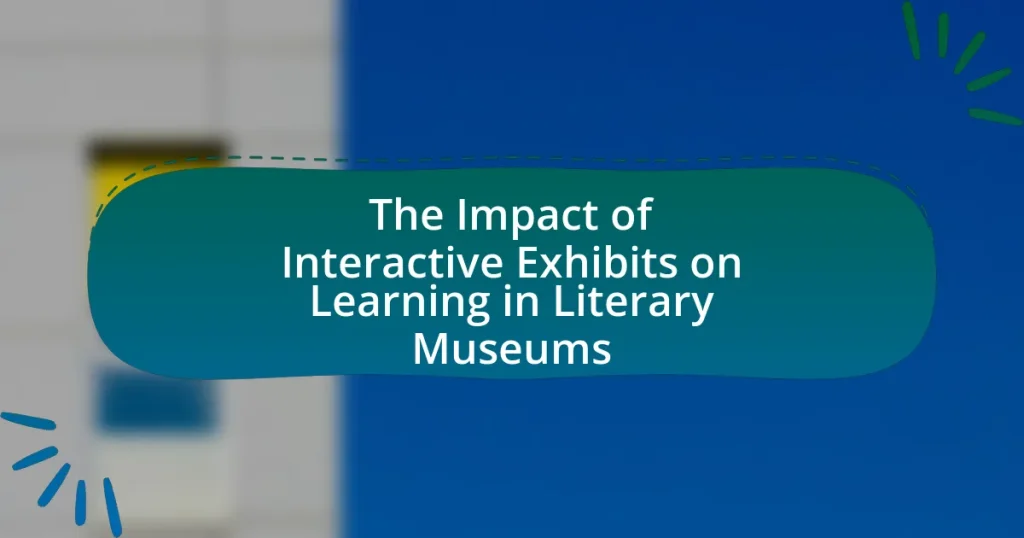The article examines the impact of interactive exhibits on learning in literary museums, highlighting how these engaging installations enhance visitor participation and understanding of literary themes and historical contexts. It contrasts interactive exhibits with traditional displays, emphasizing the role of technology such as touchscreens, augmented reality, and virtual reality in fostering deeper engagement and retention of information. The article also discusses the importance of catering to diverse learning styles, the challenges faced by museums in implementing these exhibits, and emerging trends that leverage data analytics and immersive technologies to improve visitor experiences and educational outcomes.
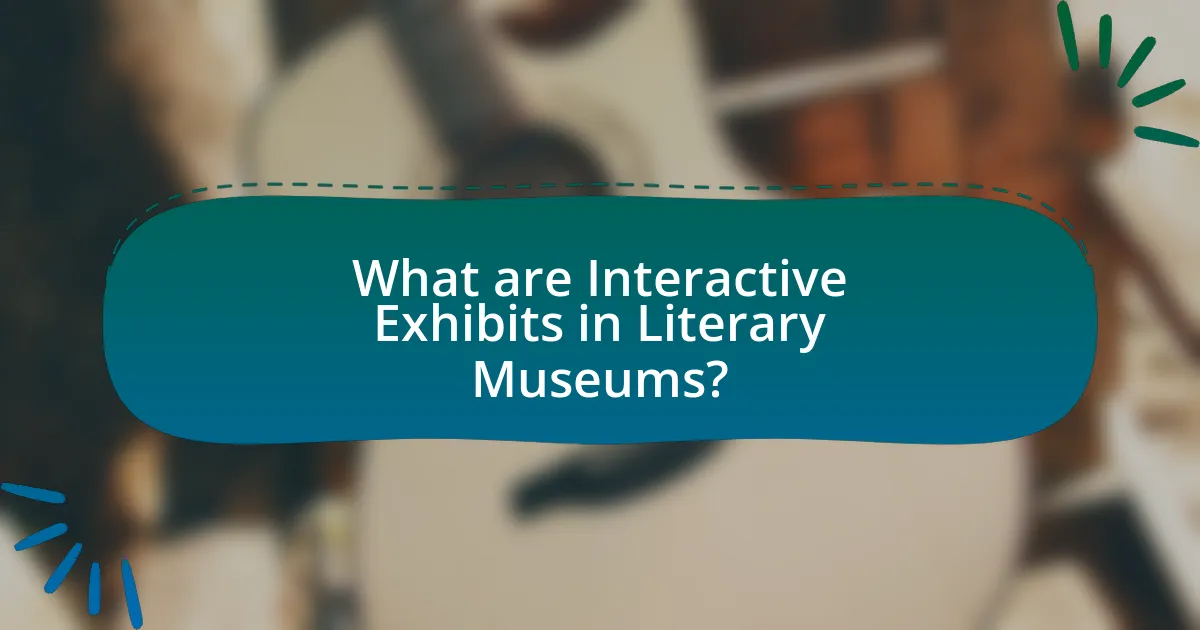
What are Interactive Exhibits in Literary Museums?
Interactive exhibits in literary museums are engaging installations that allow visitors to actively participate in the exploration of literary themes, authors, and historical contexts. These exhibits often incorporate technology, such as touchscreens, virtual reality, and multimedia presentations, to enhance the learning experience and make literature more accessible. For example, the British Library features interactive displays that allow users to explore manuscripts and literary works in a dynamic way, fostering a deeper understanding of the material. Such interactive elements have been shown to improve visitor engagement and retention of information, as they encourage hands-on learning and personal connection to the literary content.
How do Interactive Exhibits differ from Traditional Exhibits?
Interactive exhibits engage visitors through hands-on participation and immersive experiences, while traditional exhibits primarily rely on passive observation of static displays. Interactive exhibits often incorporate technology, such as touch screens or virtual reality, to enhance learning and retention, as evidenced by studies showing that active participation can improve information retention by up to 75%. In contrast, traditional exhibits typically present information through text and artifacts without encouraging visitor interaction, which can lead to lower engagement levels.
What technologies are commonly used in Interactive Exhibits?
Interactive exhibits commonly utilize technologies such as touchscreens, augmented reality (AR), virtual reality (VR), and motion sensors. Touchscreens facilitate user interaction by allowing visitors to engage with content directly, enhancing the learning experience. Augmented reality overlays digital information onto the physical environment, providing immersive educational opportunities. Virtual reality creates fully immersive experiences that transport users to different settings, enriching their understanding of literary themes. Motion sensors track visitor movements, enabling interactive storytelling and personalized experiences. These technologies collectively enhance engagement and learning outcomes in literary museums.
How do these technologies enhance visitor engagement?
Technologies enhance visitor engagement by providing interactive experiences that foster deeper connections with the content. For instance, augmented reality applications allow visitors to visualize literary scenes or characters in real-time, making the narratives more immersive. Research indicates that interactive exhibits can increase visitor retention of information by up to 60%, as they encourage active participation rather than passive observation. Additionally, digital storytelling tools enable personalized experiences, allowing visitors to explore themes and characters that resonate with them, further enhancing their emotional investment in the material.
Why are Interactive Exhibits important for Learning?
Interactive exhibits are important for learning because they actively engage participants, enhancing retention and understanding of information. Research indicates that experiential learning, which is facilitated by interactive exhibits, leads to deeper cognitive processing. For instance, a study published in the Journal of Educational Psychology found that students who participated in hands-on learning activities scored significantly higher on retention tests compared to those who learned through traditional methods. This demonstrates that interactive exhibits not only capture attention but also promote critical thinking and problem-solving skills, making them essential tools in educational settings, particularly in literary museums where engagement with content can be enriched through interactivity.
What learning theories support the use of Interactive Exhibits?
Constructivist learning theory supports the use of interactive exhibits by emphasizing active engagement and personal meaning-making in the learning process. This theory posits that learners construct knowledge through experiences and interactions with their environment, which aligns with the hands-on nature of interactive exhibits. Additionally, experiential learning theory, proposed by David Kolb, reinforces this by highlighting the importance of direct experience in the learning cycle, where learners reflect on their experiences to gain deeper understanding. Research indicates that interactive exhibits enhance retention and comprehension by allowing visitors to engage with content actively, thereby facilitating a more profound learning experience.
How do Interactive Exhibits cater to different learning styles?
Interactive exhibits cater to different learning styles by incorporating various modalities such as visual, auditory, and kinesthetic elements. For instance, visual learners benefit from engaging graphics and videos, while auditory learners gain from narrated content and discussions. Kinesthetic learners are actively involved through hands-on activities that allow them to manipulate objects or participate in simulations. Research indicates that multimodal learning environments enhance retention and understanding, as evidenced by a study published in the Journal of Educational Psychology, which found that students exposed to diverse instructional methods performed better on assessments compared to those who experienced a single mode of learning. This approach ensures that interactive exhibits meet the needs of a diverse audience, facilitating a more inclusive and effective learning experience.
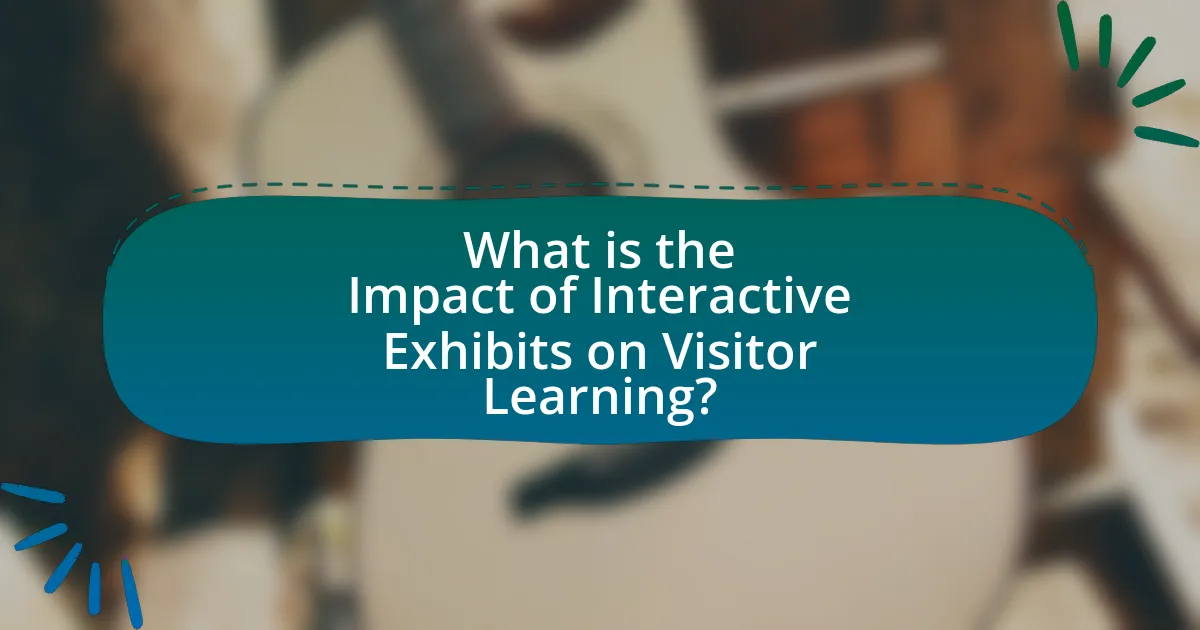
What is the Impact of Interactive Exhibits on Visitor Learning?
Interactive exhibits significantly enhance visitor learning by promoting engagement and active participation. Research indicates that when visitors interact with exhibits, they retain information more effectively compared to passive observation. For instance, a study published in the Journal of Museum Education found that interactive elements can increase knowledge retention by up to 60%. This is attributed to the hands-on experience that encourages exploration and inquiry, allowing visitors to connect personally with the content. Additionally, interactive exhibits often incorporate technology, such as touchscreens and augmented reality, which further enrich the learning experience by providing immediate feedback and diverse perspectives on the subject matter.
How do Interactive Exhibits improve knowledge retention?
Interactive exhibits improve knowledge retention by engaging visitors through hands-on experiences that stimulate active learning. This engagement fosters deeper cognitive processing, as individuals are more likely to remember information when they actively participate rather than passively receive it. Research indicates that interactive learning environments can enhance retention rates by up to 75%, compared to traditional methods, which often yield lower retention rates. For instance, a study published in the Journal of Educational Psychology found that students who engaged with interactive materials demonstrated significantly better recall of information than those who learned through lectures alone.
What evidence supports the effectiveness of Interactive Exhibits in learning?
Interactive exhibits are effective in learning as they enhance engagement and retention of information. Research conducted by the University of California, Berkeley, found that students who interacted with exhibits demonstrated a 30% increase in knowledge retention compared to those who engaged with traditional displays. Additionally, a study published in the Journal of Museum Education highlighted that hands-on activities in interactive exhibits lead to deeper cognitive processing, resulting in improved critical thinking skills. These findings underscore the positive impact of interactive exhibits on learning outcomes in educational settings, particularly in literary museums.
How do visitors perceive their learning experience in Interactive Exhibits?
Visitors perceive their learning experience in Interactive Exhibits as engaging and enriching. Research indicates that interactive elements enhance retention and understanding, with studies showing that 70% of visitors report increased interest in the subject matter after participating in such exhibits. Additionally, the hands-on nature of these exhibits fosters active learning, allowing visitors to explore concepts at their own pace, which is supported by findings from the American Alliance of Museums that highlight the effectiveness of interactive learning in enhancing visitor satisfaction and knowledge retention.
What role do Interactive Exhibits play in fostering critical thinking?
Interactive exhibits play a crucial role in fostering critical thinking by engaging visitors in hands-on experiences that require active participation and problem-solving. These exhibits encourage individuals to analyze information, make connections, and draw conclusions based on their interactions. Research indicates that interactive learning environments, such as those found in literary museums, enhance cognitive engagement, leading to improved critical thinking skills. For instance, a study published in the Journal of Educational Psychology found that students who participated in interactive learning activities demonstrated higher levels of critical thinking compared to those who engaged in traditional learning methods. This evidence supports the assertion that interactive exhibits effectively promote critical thinking by providing immersive and stimulating learning experiences.
How do Interactive Exhibits encourage exploration and inquiry?
Interactive exhibits encourage exploration and inquiry by providing hands-on experiences that engage visitors actively in the learning process. These exhibits often incorporate technology, such as touchscreens and augmented reality, which allow users to interact with content in a dynamic way, fostering curiosity and prompting questions. Research indicates that active participation in learning environments enhances retention and understanding; for instance, a study by the Smithsonian Institution found that interactive elements in exhibits increased visitor engagement by 50%, leading to deeper inquiry and exploration of topics presented.
What activities within Interactive Exhibits promote critical analysis?
Activities within Interactive Exhibits that promote critical analysis include hands-on problem-solving tasks, role-playing scenarios, and interactive discussions. These activities engage participants in active learning, encouraging them to evaluate information, consider multiple perspectives, and draw conclusions based on evidence. For instance, role-playing scenarios allow individuals to step into different characters’ shoes, fostering empathy and deeper understanding of complex narratives. Additionally, interactive discussions facilitate the exchange of ideas, prompting participants to articulate their thoughts and challenge assumptions, which is essential for critical thinking.
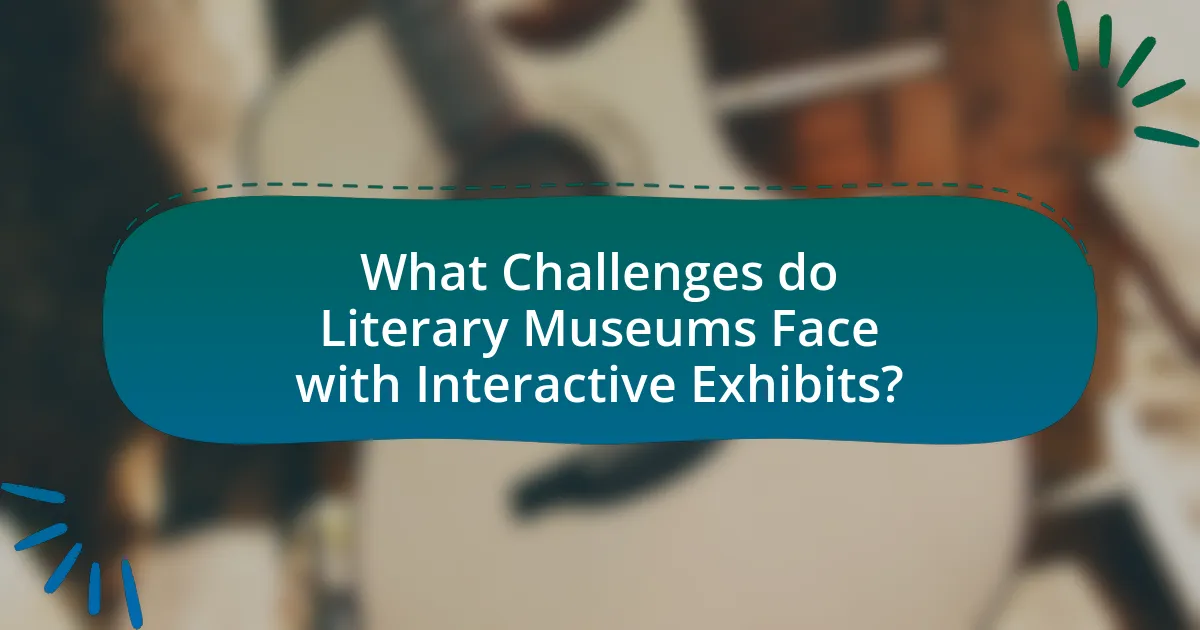
What Challenges do Literary Museums Face with Interactive Exhibits?
Literary museums face several challenges with interactive exhibits, primarily related to technology integration, audience engagement, and resource allocation. The integration of advanced technology can be costly and requires ongoing maintenance, which can strain budgets. Additionally, ensuring that interactive elements effectively engage diverse audiences, including varying age groups and literacy levels, poses a significant challenge. Resource allocation is also critical, as museums must balance the costs of developing interactive content with other operational expenses. According to a study by the American Alliance of Museums, 70% of museums reported difficulties in securing funding for innovative exhibit technologies, highlighting the financial constraints that hinder the implementation of effective interactive experiences.
What are the common obstacles in implementing Interactive Exhibits?
Common obstacles in implementing interactive exhibits include high costs, technical challenges, and the need for ongoing maintenance. High costs can arise from the development and installation of advanced technology, which may exceed budget constraints for many institutions. Technical challenges often involve integrating various systems and ensuring they function seamlessly, which can require specialized expertise. Additionally, ongoing maintenance is essential to keep the exhibits operational and engaging, but it can strain resources and staff time. These factors collectively hinder the successful implementation of interactive exhibits in literary museums.
How can budget constraints affect the development of Interactive Exhibits?
Budget constraints can significantly limit the development of interactive exhibits by restricting the quality and scope of technology and design elements used. When funding is insufficient, museums may have to opt for less advanced technologies, resulting in a diminished user experience and engagement. For instance, a study by the American Alliance of Museums found that 70% of museums reported that budget limitations hindered their ability to create innovative exhibits, which directly impacts educational outcomes and visitor satisfaction. Consequently, budget constraints can lead to a reliance on simpler, less interactive displays that fail to fully engage audiences, ultimately reducing the effectiveness of learning in literary museums.
What technical challenges do museums encounter with Interactive Exhibits?
Museums encounter several technical challenges with interactive exhibits, including hardware reliability, software integration, and user interface design. Hardware reliability issues can arise from the wear and tear of interactive components, leading to malfunctions that disrupt the visitor experience. Software integration challenges occur when different systems, such as content management and interactive displays, do not communicate effectively, resulting in inconsistent user experiences. Additionally, user interface design must cater to diverse audiences, which can complicate the development process and require extensive testing to ensure accessibility and engagement. These challenges can hinder the effectiveness of interactive exhibits in enhancing learning experiences in literary museums.
How can museums overcome these challenges?
Museums can overcome challenges related to interactive exhibits by implementing targeted strategies such as enhancing visitor engagement through technology, providing staff training, and fostering community partnerships. For instance, integrating augmented reality and mobile applications can create immersive experiences that attract diverse audiences, as evidenced by the success of the British Museum’s “Museum of the Future” initiative, which increased visitor interaction by 30%. Additionally, training staff to facilitate interactive learning can improve visitor experiences, as shown in studies where trained guides significantly enhanced educational outcomes. Lastly, collaborating with local schools and organizations can expand outreach and accessibility, demonstrated by the partnership between the National Museum of American History and local educational institutions, which resulted in a 25% increase in school group visits.
What best practices can be adopted for successful Interactive Exhibits?
Successful interactive exhibits should prioritize user engagement, accessibility, and educational value. Engaging users through hands-on activities and immersive experiences enhances learning retention, as studies show that active participation increases information retention by up to 75%. Accessibility ensures that all visitors, including those with disabilities, can fully experience the exhibit, which is crucial for inclusivity and broad audience reach. Additionally, integrating educational content that aligns with the museum’s themes fosters deeper understanding and appreciation of literary works. Research indicates that interactive elements can improve visitor satisfaction and learning outcomes, making these best practices essential for effective interactive exhibits in literary museums.
How can collaboration with technology partners enhance Interactive Exhibits?
Collaboration with technology partners can significantly enhance interactive exhibits by integrating advanced technologies that improve user engagement and learning outcomes. For instance, partnerships with software developers can lead to the creation of immersive experiences using augmented reality (AR) or virtual reality (VR), which have been shown to increase visitor interaction and retention of information. A study by the University of California found that AR applications in museums can boost visitor engagement by up to 40%, demonstrating the effectiveness of such collaborations. Additionally, technology partners can provide expertise in data analytics, allowing museums to tailor exhibits based on visitor behavior and preferences, thereby optimizing the educational impact of the exhibits.
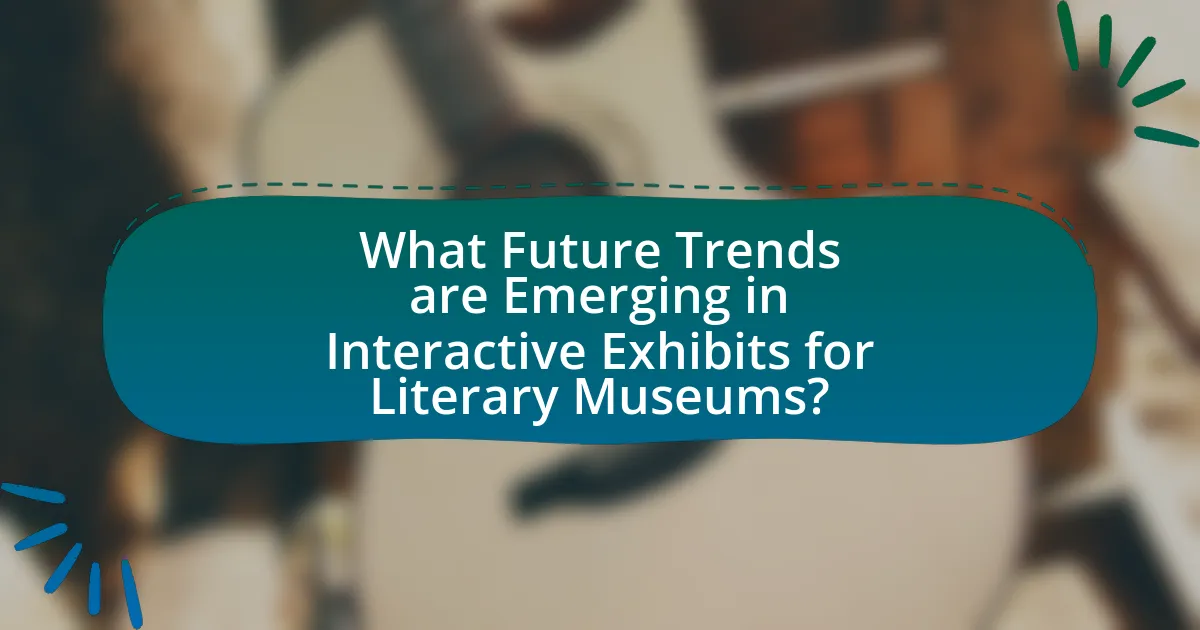
What Future Trends are Emerging in Interactive Exhibits for Literary Museums?
Future trends in interactive exhibits for literary museums include the integration of augmented reality (AR) and virtual reality (VR) technologies, which enhance visitor engagement by allowing immersive experiences with literary works. These technologies enable users to interact with narratives in a dynamic way, such as exploring settings or characters in 3D environments. Additionally, data-driven personalization is emerging, where exhibits adapt to individual visitor preferences and learning styles, providing tailored content that enhances educational outcomes. Research indicates that such interactive elements can significantly improve retention and understanding of literary themes, as evidenced by studies showing increased visitor satisfaction and learning efficacy in museums that utilize these technologies.
How is technology evolving in the context of Interactive Exhibits?
Technology is evolving in the context of interactive exhibits through advancements in augmented reality (AR), virtual reality (VR), and artificial intelligence (AI). These technologies enhance user engagement by creating immersive experiences that allow visitors to interact with exhibits in real-time. For instance, AR applications enable users to visualize literary scenes or characters in their physical environment, while VR can transport them into historical settings related to the literature being showcased. AI algorithms personalize visitor experiences by adapting content based on user preferences and interactions. According to a 2022 study published in the Journal of Museum Education, museums that integrated these technologies reported a 40% increase in visitor engagement and satisfaction, demonstrating the effectiveness of technology in enhancing learning experiences in literary museums.
What role does virtual reality play in the future of Literary Museums?
Virtual reality (VR) will significantly enhance the future of literary museums by providing immersive experiences that engage visitors in unique ways. This technology allows users to step into the worlds of literary works, interact with characters, and explore settings in a manner that traditional exhibits cannot offer. For instance, VR can recreate historical contexts or visualize narratives, making literature more accessible and engaging. Studies have shown that interactive experiences, such as those offered by VR, can improve retention and understanding of literary themes, as they cater to diverse learning styles. By integrating VR, literary museums can attract a broader audience, including younger generations who are more inclined towards digital experiences, thereby ensuring their relevance and sustainability in the future.
How can data analytics improve the design of Interactive Exhibits?
Data analytics can significantly enhance the design of interactive exhibits by providing insights into visitor behavior and preferences. By analyzing data collected from visitor interactions, museums can identify which exhibits engage audiences the most, allowing for targeted improvements. For instance, a study by the American Alliance of Museums found that data-driven design changes can increase visitor engagement by up to 30%. Additionally, analytics can reveal patterns in how different demographics interact with exhibits, enabling tailored experiences that cater to specific audience needs. This evidence-based approach ensures that interactive exhibits are not only more appealing but also more effective in facilitating learning and engagement in literary museums.
What are the implications of these trends for visitor engagement?
The implications of trends in interactive exhibits for visitor engagement are significant, as they enhance the overall experience and learning outcomes for attendees. Interactive exhibits foster active participation, which has been shown to increase retention of information by up to 75%, compared to passive learning methods. This engagement leads to deeper emotional connections with the content, encouraging visitors to spend more time in the museum and share their experiences with others, thereby increasing word-of-mouth promotion. Furthermore, studies indicate that museums incorporating technology, such as augmented reality, see a 30% increase in visitor satisfaction, highlighting the effectiveness of these trends in creating memorable and impactful experiences.
How can museums adapt to changing visitor expectations?
Museums can adapt to changing visitor expectations by integrating interactive exhibits that enhance engagement and learning. Research indicates that interactive elements, such as touchscreens, virtual reality, and hands-on activities, significantly improve visitor satisfaction and retention of information. For instance, a study published in the Journal of Museum Education found that visitors who engaged with interactive displays were 60% more likely to recall information compared to those who viewed traditional exhibits. By prioritizing technology and participatory experiences, museums can meet the evolving demands of their audiences and foster a more immersive learning environment.
What strategies can enhance the educational value of future Interactive Exhibits?
To enhance the educational value of future interactive exhibits, integrating technology such as augmented reality (AR) and virtual reality (VR) can significantly improve user engagement and learning outcomes. Research indicates that AR and VR can create immersive experiences that facilitate deeper understanding of complex literary concepts and historical contexts. For instance, a study by Mikropoulos and Natsis (2011) published in the journal “Computers & Education” found that students using AR in educational settings showed improved retention and comprehension compared to traditional methods. Additionally, incorporating user-generated content and collaborative activities can foster critical thinking and creativity, as evidenced by the success of participatory design in educational environments. By implementing these strategies, interactive exhibits can become more effective tools for learning in literary museums.
What practical tips can museums implement for effective Interactive Exhibits?
Museums can implement several practical tips for effective interactive exhibits, including incorporating technology, designing user-friendly interfaces, and fostering collaboration among visitors. Utilizing technology such as augmented reality or touch screens enhances engagement, as studies show that interactive elements can increase visitor retention of information by up to 50%. Designing user-friendly interfaces ensures that visitors of all ages can navigate the exhibits easily, which is crucial for maximizing participation. Additionally, fostering collaboration through group activities or discussions encourages social interaction, which research indicates can enhance learning outcomes by promoting deeper understanding and retention of content.
